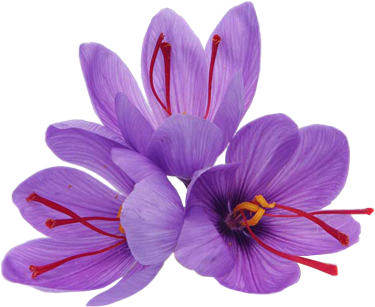
The cultivation of saffron (Crocus Sativus) is peculiar and the legend about its introduction into Kashmir shows at any rate that it is an ancient industry. In the time of king Lalta Dit there was a famous physician in Padampur, the city founded by Lalta Dits minister, wazir Padam. A nag or water - God, fell sick of an eye complained and went to physician, who tried in vain to cure him. Baffled, the physician at last asked the water-God whether he was a man , and on finding out that he was a 'nag' he at once sew that the remedies applied to the nags eyes were nullified by the poisonous vapours which issued from the water-Gods mouth. He bound his eyes with a cloth and the nag was restored to health. In this gratitude the 'nag' gave the physician a bulb of saffron and the cultivation sprang up at Padampur, now known as Pampore.
At present cultivation is extending as fast as the local method of seed production will allow. But this method is slow may be inferred from the fact that at measurement of a total area of 14527 acres of saffron land only 132 acres were actually cultivated with the crocus. In former days the saffron cultivation was large of source of revenue to the state, but it is famine the people in their distress ate up bulbs, and although seed has been imported from Kishtawar, and although every year land is set apart for the production of seeds, the process of reproduction is slow for seed purpose a particular aspect and sloping ground is required, and it takes three years before the bulbs planted out in a small square plots where it is grown.
There plots must remain fallow of eight years, and no manure can be given to them and no assistance given in way of water. When once the bulb has been placed in the square, it will live on for fourteen years without any help from the cultivator, new bulb being produced and old bulb rotting away. The time for planting out the bulbs is in August and September, and all the cultivator has to do is to break up the surface gently a few times and to ensure the proper drainage of the plot by digging a neat trench on all four sides.
The flowers appear about the middle of October, and the purple blooms and the delicious, though somewhat overpowering sent of the saffron turn dry, uninviting plateau above Pampore into a rear and wonderful garden. Saffron is at present limited to the Karewas in the neighborhood of Pampore. In former days the men came from all parts of Kashmir to cultivate saffron on the Pampore and Karewas, but now, with the exception of a few men from Srinagar the cultivation is in the hands of local men.
When the flowers are collected the rear work of extracting saffron commences, the three long stigmas are picked out by the hand and the picked stigmas are dried up the shadows of sunlight.

 Cart:
Cart:  CheckOut
CheckOut 391, Zakir Nagar, 3rd Floor, Near State Bank Of
391, Zakir Nagar, 3rd Floor, Near State Bank Of  011-26987380, +91-9811488221, +91-7503228725,
011-26987380, +91-9811488221, +91-7503228725,  marketing@kashmirkesarleader.com,
marketing@kashmirkesarleader.com,